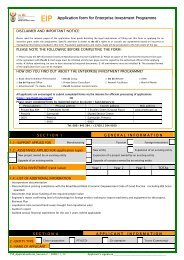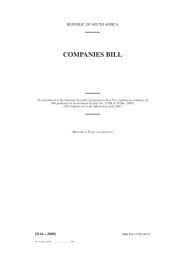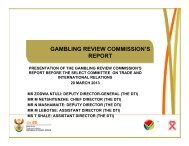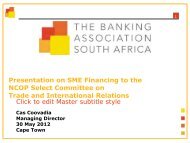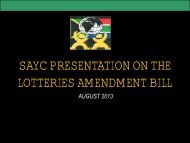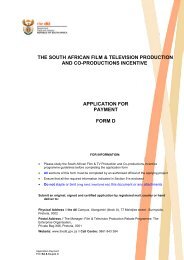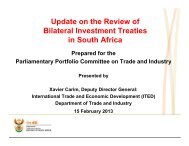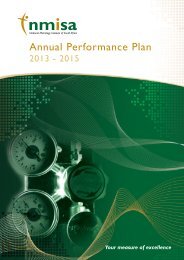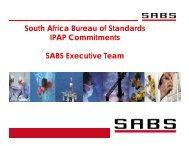Copyright Review Commission Report - ICT Law and Regulation ...
Copyright Review Commission Report - ICT Law and Regulation ...
Copyright Review Commission Report - ICT Law and Regulation ...
- No tags were found...
Create successful ePaper yourself
Turn your PDF publications into a flip-book with our unique Google optimized e-Paper software.
Areas that require improvements include: Although there is one collecting society per right (for example, IPRS is the collecting society for musical works <strong>and</strong> PPLis the collecting society for sound recording) in most cases, the users who are obliged to pay for the sound recordingare also obliged to pay for the public performance rights. The fact that they have to deal with both PPL <strong>and</strong> IPRS isirritating <strong>and</strong> inefficient; The levels of synergies arising from the existence of two music collecting societies are minimised (no sharing of usersdatabases, collection efforts are duplicated, negotiation efforts are also duplicated); A high rate of tariffs disputes are referred to the <strong>Copyright</strong> Board. This is due to the fact that the collecting societies areresponsible for setting up the tariffs <strong>and</strong> the users generally believe that, due to the monopolistic environment, theprocess of setting up the tariff is always in favour of the collecting societies; Only 30% of the current users of music rights pay for the utilisation of rights. This is because there is a significantnumber of informal businesses; some of the users are unaware of the fact that they need licences; <strong>and</strong> the inspectionscost is too high to justify the tracking of all users; The local industry is not protected against music import. This, however, is not a problem for the country because theexports exceed import; The country has not yet adopted the International Financial <strong>Report</strong>ing St<strong>and</strong>ards (IFRS) <strong>and</strong> as such the level ofaccounting disclosure (transparency with regard to the financial status of the collecting societies) is limited; No corporate governance practices are in place to guide the entities; <strong>and</strong> For sound recording, the tariffs are not published <strong>and</strong> there is high level of inconsistency between users within the sameindustry.4. NORWAY4.1. MEETING WITH KOPINOR – the dtiOn Monday, 6 June 2011, I met with KOPINOR at their offices in the city centre of Oslo, Norway. I had travelled to themeeting venue via the bus shuttle from my out-of-town hotel. The bus took me to the Oslo Airport, where I boarded the localtrain to National Theatre Station in the city centre. I was to repeat the journey for the next few days, sometimes alighting atOSLO Central Station.At the KOPINOR offices I was met by Heidi Wollo, before meeting with Helge <strong>and</strong> the Deputy Executive Director, Mr Hans-Petter Fugl<strong>and</strong>. The title of our topic was: “Collective Management of Reprographic <strong>and</strong> Similar Rights”. It relates to the termsof reference that states:Assess licensing agreements that universities, other institutions of higher learning <strong>and</strong> training institutions have with collecting societiesregarding royalties for copyright work or literary work; <strong>and</strong> how these royalties are distributed to collecting societies <strong>and</strong> from there on toartists, composers, authors <strong>and</strong>/or publishers. The CRC should assess, advise <strong>and</strong> make recommendations.KOPINOR came into being in 1980. During the 1970s, the Norwegian government took an interest in the publishing of localbooks in order to promote the creative economy through writing. The government wanted creative people to make a- 141 -



